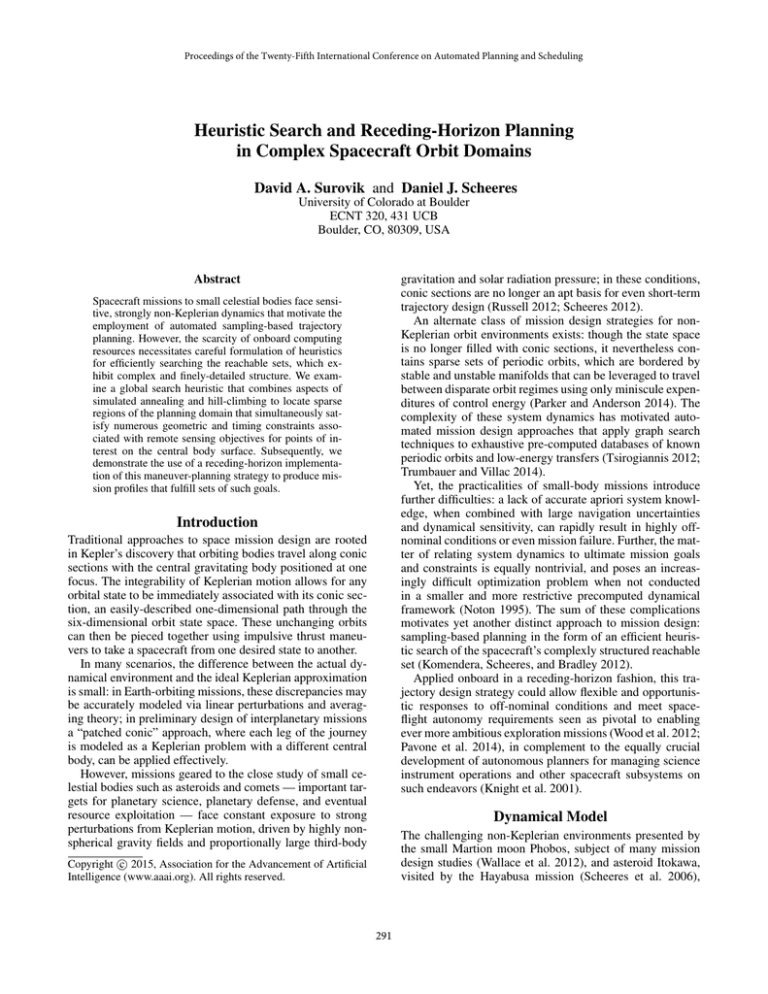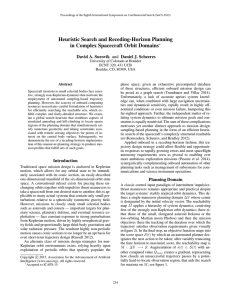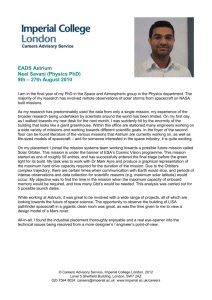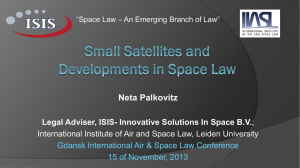
Proceedings of the Twenty-Fifth International Conference on Automated Planning and Scheduling
Heuristic Search and Receding-Horizon Planning
in Complex Spacecraft Orbit Domains
David A. Surovik and Daniel J. Scheeres
University of Colorado at Boulder
ECNT 320, 431 UCB
Boulder, CO, 80309, USA
gravitation and solar radiation pressure; in these conditions,
conic sections are no longer an apt basis for even short-term
trajectory design (Russell 2012; Scheeres 2012).
An alternate class of mission design strategies for nonKeplerian orbit environments exists: though the state space
is no longer filled with conic sections, it nevertheless contains sparse sets of periodic orbits, which are bordered by
stable and unstable manifolds that can be leveraged to travel
between disparate orbit regimes using only miniscule expenditures of control energy (Parker and Anderson 2014). The
complexity of these system dynamics has motivated automated mission design approaches that apply graph search
techniques to exhaustive pre-computed databases of known
periodic orbits and low-energy transfers (Tsirogiannis 2012;
Trumbauer and Villac 2014).
Yet, the practicalities of small-body missions introduce
further difficulties: a lack of accurate apriori system knowledge, when combined with large navigation uncertainties
and dynamical sensitivity, can rapidly result in highly offnominal conditions or even mission failure. Further, the matter of relating system dynamics to ultimate mission goals
and constraints is equally nontrivial, and poses an increasingly difficult optimization problem when not conducted
in a smaller and more restrictive precomputed dynamical
framework (Noton 1995). The sum of these complications
motivates yet another distinct approach to mission design:
sampling-based planning in the form of an efficient heuristic search of the spacecraft’s complexly structured reachable
set (Komendera, Scheeres, and Bradley 2012).
Applied onboard in a receding-horizon fashion, this trajectory design strategy could allow flexible and opportunistic responses to off-nominal conditions and meet spaceflight autonomy requirements seen as pivotal to enabling
ever more ambitious exploration missions (Wood et al. 2012;
Pavone et al. 2014), in complement to the equally crucial
development of autonomous planners for managing science
instrument operations and other spacecraft subsystems on
such endeavors (Knight et al. 2001).
Abstract
Spacecraft missions to small celestial bodies face sensitive, strongly non-Keplerian dynamics that motivate the
employment of automated sampling-based trajectory
planning. However, the scarcity of onboard computing
resources necessitates careful formulation of heuristics
for efficiently searching the reachable sets, which exhibit complex and finely-detailed structure. We examine a global search heuristic that combines aspects of
simulated annealing and hill-climbing to locate sparse
regions of the planning domain that simultaneously satisfy numerous geometric and timing constraints associated with remote sensing objectives for points of interest on the central body surface. Subsequently, we
demonstrate the use of a receding-horizon implementation of this maneuver-planning strategy to produce mission profiles that fulfill sets of such goals.
Introduction
Traditional approaches to space mission design are rooted
in Kepler’s discovery that orbiting bodies travel along conic
sections with the central gravitating body positioned at one
focus. The integrability of Keplerian motion allows for any
orbital state to be immediately associated with its conic section, an easily-described one-dimensional path through the
six-dimensional orbit state space. These unchanging orbits
can then be pieced together using impulsive thrust maneuvers to take a spacecraft from one desired state to another.
In many scenarios, the difference between the actual dynamical environment and the ideal Keplerian approximation
is small: in Earth-orbiting missions, these discrepancies may
be accurately modeled via linear perturbations and averaging theory; in preliminary design of interplanetary missions
a “patched conic” approach, where each leg of the journey
is modeled as a Keplerian problem with a different central
body, can be applied effectively.
However, missions geared to the close study of small celestial bodies such as asteroids and comets — important targets for planetary science, planetary defense, and eventual
resource exploitation — face constant exposure to strong
perturbations from Keplerian motion, driven by highly nonspherical gravity fields and proportionally large third-body
Dynamical Model
The challenging non-Keplerian environments presented by
the small Martion moon Phobos, subject of many mission
design studies (Wallace et al. 2012), and asteroid Itokawa,
visited by the Hayabusa mission (Scheeres et al. 2006),
c 2015, Association for the Advancement of Artificial
Copyright Intelligence (www.aaai.org). All rights reserved.
291
Planning Domain
are used to demonstrate the automated planning scheme. A
spacecraft is modeled as a massless point, whose kinematic
state x is described within the rotating, body-fixed frame to
facilitate natural expression of gravitation and science goals.
Despite the starkly atypical orbit environment, the classic
control input paradigm of intermittent impulsive-thrust maneuvers remains most appropriate: a continuous-thrust approach would further exacerbate the curse of dimensionality
in the search of the mission design space, while also complicating the spacecraft’s ability to simultaneously operate science subsystems; a frequent-impulse scheme, i.e. inertial or
body-fixed hovering, would incur excessive fuel costs over
time. Furthermore, both of these alternatives would introduce undue noise into the process of orbit determination and
system parameter estimation.
Thus, the planning domain for a single leg of the mission
is given as (Δt, ΔV), where Δt is the time elapsed since
previous maneuver’s occurrence at tk−1 and ΔV describes a
velocity-space sphere of radius Δvmax centered at ṙ (t).
T
x = (r, ṙ) = [ x y z ẋ ẏ ż ]
(1)
The equations of motion evolve the state through time via
rotating-frame accelerations governed by the constant angular velocity vector ω, by the gravitational acceleration g of
the body’s irregular shape, approximated as a triaxial ellipsoid, and in the case of Phobos also by the tidal accelerations gM resulting from the different Mars-relative altitudes
of Phobos and the spacecraft (Scheeres 2012).
(2)
r̈ = − ω × (ω × r) − 2ω × ṙ + g (r) + gM (r)
These equations produce trajectories through state space;
next, various measures of objective fulfillment are taken.
Remote sensing of each point of interest (POI) on the
body surface may occur when four topocentric constraints
are satisfied. To observe the i-th POI, located at ri , the spacecraft must fall within prescribed bounds of azimuth θ, elevation ϕ, and range ρ relative to that point (shown as colored
regions in figure 3) while the Sun elevation ϕs falls within
prescribed bounds — a timing requirement. Since these constraints might only rarely be met simultaneously, they are
each tracked continuously to aid the heuristic search for such
occurrences.
For generic observation parameter a with ideal value a∗ ,
the quality qa ∈ [0, 1] is a function of its actual, dropoff, and
cutoff deviations: δ(a) = |a − a∗ |, δd , and δc respectively.
⎧
⎪
if δ > δc
⎨0
δ−δd
(3)
qa (δ) = δc −δd if δd < δ < δc
⎪
⎩1
if δ < δd
(Δt, ΔV) = {[Δtmin , Δtf ail − Δtcushion ]} × · · ·
Δv ∈ R3 Δv < Δvmax
(9)
The margins Δtmin and Δtcushion enforce practicality of
plan implementation by restricting the the temporal proximity of selected maneuvers to critical events: i.e., a sufficient
duration must elapse to accomodate the planner’s runtime
between maneuvers. This same restriction, with additional
built-in margin-of-error, is applied to the end of the temporal
planning domain to allow sufficient time for action in avoidance of failure scenarios, e.g. impact of the central body. If
failure does not occur within the prediction horizon Δtmax ,
which for this investigation is twice the Keplerian approximation of the orbit period at an altitude equivalent to the
central body’s mean radius, then Δtf ail = Δtmax .
The state-space dynamics F (Eq. 2) map from this planning domain to full sets of reachable trajectories X̃ and subsequently to associated mission result sets Y via the mission
dynamics G (Eqns. 3–6; observation metrics given visually
in figure 3). Lastly, an automated planner H must evaluate
these results to assign scores S(t) that determine which action within the planning domain will be taken.
This produces acceptable bounds [a∗ − δd , a∗ + δd ] outside
of which the quality metric linearly decreases to zero. The
set {qa } then defines the overall quality metric Qi ∈ [0, 1]
using either the product LΠ or n-norm Ln of all qa .
(4)
Qi =L(qθ , qϕ , qρ , qϕs )
⎧
⎞1/n ⎫
⎛
⎪
⎪
jf
jf
⎨
1 n⎠ ⎬
L ∈ LΠ =
q a j , Ln = ⎝
q aj
(5)
⎪
⎪
jf j
⎩
⎭
j
F
G
H
(tk , x (tk ) + ΔV) −→ X̃ (t) −→ Y(t) −→ S(t)
(10)
The reachability map M used to inform trajectory planning
can thus be described in condensed form as below, with the
time horizon variably truncated to maximize score.
These functions can be used to alter the character of the gradients leading up to the sparse goal-fulfilling regions.
Duration gi of successful observation of the i-th target is
accumulated at a constant rate ġi = 1 while all constraints
are satisfied and the target value gi,cap has not yet been met:
1 if (Qi == 1) and (gi < gi,cap )
(6)
ġi (r, t) =
0 otherwise
All mission outcome data are stored within the vector y,
with each POI’s parameters grouped together as gi
(7)
y (t) = g1 g2 · · · gng
(8)
gi (t) = {q (aj )} Qi Q̂i (x̃) ġi gi (x̃)
M : (Δtŝ , ΔV; tk−1 , xk−1 ) −→ S
(11)
As an illustrative example, we select an initial position r
at the first Lagrange point of the Mars-Phobos system, where
their gravitational pulls precisely null out the acceleration of
their co-rotating frame. Figure 1 plots a level surface within
the map (0, ΔV) −→ Q̂max , which bounds a subdomain
of maneuvers whose resultant trajectories come close to fulfilling remote sensing requirements of one or more targets.
True goal regions, where Q̂max = 1, compose only a small
fraction of the displayed region.
Heuristic Search
where the historical maximum quality Q̂i , which is used to
identify near misses of goal regions, and the accumulated
observation time gi both depend on the trajectory history x̃.
The nonintegrability of the dynamical model necessitates a
sampling-based approach for charting the reachability map
292
Result: Monte Carlo mean results of heuristic searches of
a planning domain at Itokawa are plotted below in figure 2
for three varieties of L, in addition to a heuristic that does
not exploit quality gradients Q̂ and a standard grid search.
Searches were seeded with 400 vertices before undergoing
50 progressively smaller refinement iterations, resulting in a
final resolution of 2000 vertices within 30 seconds of runtime on a 2.2 GHz Intel Core 2 CPU.
All gradient-augmented heuristics performed well, exhibiting minor trade-offs between speed and scoreattainment upper bound, associated with gradient sharpness.
The gradient-free heuristic fared less favorably but nonetheless outperformed a standard grid search. Also plotted is a
metric of sparseness for each augmented score, illustrating
how favorable scores compose a vanishingly small fraction
of the domain’s total volume. This indicates that final gains
in performance are very hard-won, and shows how gradientagumented heuristics smooth out the search for these gains.
Figure 1: Occurrences of large Q̂max in planning domain.
M . A heuristic-based mesh refinement strategy is used to
drastically improve the efficiency of this process relative to
a simple grid search (Komendera, Scheeres, and Bradley
2012; Surovik and Scheeres 2015).
Given no apriori knowledge of map content, the first set of
sampled maneuvers Δvi ∈ ΔV is distributed evenly and numerically propagated over time horizon Δtmax through asi (t) ∈ X(t) to mission results yi (t) ∈
sociated trajectories x
Y(t) and score trajectories s(t) ∈ S(t) which are lastly
reduced to their maximal values and associated lifespans
(ŝ, Δtŝ ). Next, Delaunay Triangulation is used to build this
small sample of points in M into a mesh, i.e. a set of tetrahedral “simplex” volume elements each bounded by four vertices, to allow inference of its continuous structure.
The search heuristic then operates on the mesh, assigning each j-th simplex a weight Wj based upon the extent to
which the numerically propagated results of its vertices indicate that it contains relevant missing detail. Each simplex’s
largest interior sphere is computed and its center and radius are used to define a 3D normal distribution from which
an additional maneuver is sampled each time the simplex’s
ID is drawn from a W -weighted random sample. Weights
are assigned such that the random sampling of simplex IDs
functions similarly to a sampling of the control domain via
a volumetrically-specified probability density function.
28τ
Wj =Vj mean {Δt}
max s + Q̂max
j
j
Figure 2: Left: Monte Carlo mean performance of search
heuristics. Right: Sparseness of high-scoring regions.
Receding-Horizon Planner
The preceding demonstration shows how an automated planner can select an advantageous maneuver that completes a
single science objective during a single planning cycle. To
complete an entire mission that consists of many such objectives, a receding-horizon implementation of this scheme is
applied (Surovik and Scheeres 2014), as has frequently been
deemed appropriate for aerospace vehicle motion planning
scenarios in highly dynamic environments (Lee, Longo,
and Kerrigan 2012; Morgan, Chung, and Hadaegh 2014;
Goerzer, Kong, and Mettler 2010).
Mission progress may be straightforwardly described
with the mission objective function sm (t), a normalized
measure of fulfillment of the set of ng science goals:
(12)
The first factor of the weight function, simplex volume
V , accounts for uneven sample distribution while the second, the mean trajectory lifespan, scales sample probability density in accordance with the varying temporal depth
of M . A final factor leverages the observation quality metric Q̂ to simulate a smooth gradient, whose shape depends
on the choice of quality scalarizing function L, leading up
to the potentially sparse plateaus of large s toward which
the search is biased. This factor is raised to an exponent that
varies with the search progress parameter τ , which increases
from 0 to 1 as the sampling process iterates, progressively
amplifying the bias toward high-scoring areas in a manner
akin to simulated annealing.
sm (t) =
ng
i
293
g
n
gi (t)
i
gi,cap
(13)
During each k-th planning cycle, a maximal increase
sm (t) − sm (tk−1 ) is desired. However, two additional subtleties must be accounted for in order to ensure effectiveness
of the receding-horizon scheme: the timing of maneuvers,
i.e. the selection of trajectory lifespan Δt in the planning
domain, and the augmentation of the objective function to
account for long-term consequences. The implementations
of these two points are closely interconnected.
First, the mission score increase is combined with a horizon promise function ph (x(t)), similar in purpose to a costto-go function, which defines a state-space field associating each prospective final state of a sampled trajectory with
the likelihood that it will produce a favorable velocity-space
planning domain ΔV for the next planning cycle. While the
mission score time series plateaus when the spacecraft trajectory departs an observation region, the planning horizon’s
objective function s(t) = sm (t)−sm (tk−1 )+ph (x(t)) gives
unique maxima ŝ that can be used unambiguously identify
designate the optimal trajectory lifespan Δtŝ , subject to the
bounds of practicality given in Eq. 9.
This process decouples the temporal and velocity-space
planning operations, greatly lightening the computational
burden by pruning one dimension of the search space. The
matter of avoiding over-pruning of favorable solutions is
synonymous with the selection of an effective ph . The formulation presently employed,
ph (x) =q δ (r, 0) , max {ri + ρi + δd (ρi )} , resc (14)
Figure 3: Typical mission solutions, shown in rotating bodyfixed frame, for Phobos (left) and Itokawa (right). Numbered
orange circles indicate maneuvers. Colored diamonds bound
trajectory segments that permit observations.
Figure 4: Inertial-frame view of above solution; sun-side location of diamonds (observation segments) illustrates fulfillment of timing-based surface lighting requirements.
i
enforces a preference for arc termination at altitudes in the
range associated with the observation regions, helping to ensure that they do not appear vanishingly small in M . Each
planning cycle thus uses a heuristic search to identify an
available action and trajectory lifespan (Δt, Δv) that maximize s ∈ S (t; ΔV), providing a balance of short-term
progress with long-term prospects. Repeated application of
this scheme produces mission profiles that fulfill all goals.
Result: Figures 3 and 4 show body-frame and inertialframe views of one such mission profile obtained via
these methods for each observation mission. Additionally,
a Monte Carlo analysis revealed the planning scheme to
always fulfill 95% of objectives at Phobos without ever
experiencing three successive planning horizons devoid of
progress; when instead using ph = 0, only 75% of trials met
this success rate. Total propulsion costs of about 50 m/s for
the sample mission were in line with the cost-per-day found
by previous studies for far more restricted operations that did
not approach the surface as closely (Wallace et al. 2012).
simple grid search. The low computational demands of the
demonstrative case suggest ample room for growth of complexity in the dynamical and mission goal models while still
maintaining a footprint appropriate for onboard implementation.
Future Work
Alternate formulations of the horizon promise function
ph (x) will be applied to potentially enhance planner performance by mapping and exploiting dynamical sensitivity,
e.g. via Fast Lyapunov Indicators, to improve reachability
prospects. The description of performance will also be extended beyond mere mission success by incorporating fuel
cost and mission duration into the score functions.
Moreover, as the use of receding-horizon control was motivated not only by the complexity of the mission planning
domain but also by the considerable levels of uncertainty
to be expected in estimates of the spacecraft state and of
dynamical model parameters at previously unvisited smallbody systems, robustness to these sources of error will be
a vital final aspect for demonstrating basic viability of this
planning paradigm for autonomous onboard mission design
applications. Incorporation of this aspect will be imperative
before exhaustive tuning and characterization of algorithm
performance can be effectively conducted.
Conclusions
Despite the complex structure of reachable sets for
spacecraft in strongly non-Keplerian orbit environments,
sampling-based planning appears an effective tool for pursuing elusive opportunities to conduct science operations.
Augmentation of a the objective function with a gradientsmoothing component allowed an adaptive mesh refinement
strategy to effectively transition from coarse global search to
fine local optimization via a simple mechanism akin to simulated annealing, producing a compelling advantage over a
Acknowledgments. This research is supported by
NASA Space Technology Research Fellowship grant
#NNX12AM40H.
294
References
In AIAA/AAS Astrodynamics Specialist Conference, Guidance, Navigation, and Control and Co-located Conferences.
American Institute of Aeronautics and Astronautics.
Wood, L. J.; Bhaskaran, S.; Border, J. S.; Byrnes, D. V.; Cangahuala, L. A.; Ely, T. A.; Folkner, W. M.; Naudet, C. J.;
Owen, W. M.; Riedel, J. E.; Sims, J. A.; and Wilson, R. S.
2012. Guidance, navigation, and control technology assessment for future planetary science missions, part 1: Onboard
and ground navigation and mission design. Technical report,
Strategic Missions and Advanced Concepts Office, NASA
JPL.
Goerzer, C.; Kong, Z.; and Mettler, B. 2010. A survey
of motion planning algorithms from the perspective of autonomous uav guidance. Journal of Intelligent and Robotic
Systems 57:65–100.
Knight, R.; Rabideau, G.; Chien, S.; Engelhardt, B.; and
Sherwood, R. 2001. Casper: space exploration through continuous planning. Intelligent Systems, IEEE 16(5):70–75.
Komendera, E.; Scheeres, D. J.; and Bradley, E. 2012. Intelligent computation of reachability sets for space missions.
Proceedings of the 24th Conference on Innovative Applications of Artificial Intelligence.
Lee, D.; Longo, S.; and Kerrigan, E. C. 2012. Predictive control for soaring of unpowered autonomous uavs.
4th IFAC Nonlinear Model Predictive Control Conference
4(1):194–199.
Morgan, D.; Chung, S.-J.; and Hadaegh, F. Y. 2014. Model
predictive control of swarms of spacecraft using sequential
convex programming. Journal of Guidance, Control, and
Dynamics 37(6):1725–1740.
Noton, M. 1995. Orbital strategies around a comet by means
of a genetic algorithm. Journal of Guidance, Control, and
Dynamics 18(5):1217–1220.
Parker, J. S., and Anderson, R. L. 2014. Low-Energy Lunar
Trajectory Design. Wiley.
Pavone, M.; Acikmese, B.; Nesnas, I. A.; and Starek, J.
2014. Spacecraft autonomy challenges for next generation
space missions. In Lecture Notes in Control and Information
Systems. Springer.
Russell, R. P. 2012. Survey of spacecraft trajectory design
in strongly perturbed environments. Journal of Guidance,
Control, and Dynamics 35(3):705–720.
Scheeres, D.; Gaskell, R.; Abe, S.; Barnouin-Jha, O.;
Hashimoto, T.; Kawaguchi, J.; Kubota, T.; Saito, J.;
Yoshikawa, M.; Hirata, N.; et al. 2006. The actual dynamical
environment about itokawa. AIAA paper 6661.
Scheeres, D. J. 2012. Orbital Motion in Strongly Perturbed
Environments. Praxis Springer.
Surovik, D., and Scheeres, D. J. 2014. Autonomous maneuver planning at small bodies via mission objective reachability analysis. AIAA/AAS Astrodynamics Specialist Conference.
Surovik, D. A., and Scheeres, D. J. 2015. Adaptive reachability analysis to achieve mission objectives in strongly nonkeplerian systems. Journal of Guidance, Control, and Dynamics 38(3):468–477.
Trumbauer, E., and Villac, B. 2014. Heuristic search-based
framework for onboard trajectory redesign. Journal of Guidance, Control, and Dynamics 37(1):164–175.
Tsirogiannis, G. A. 2012. A graph based methodology for
mission design. Celestial Mechanics and Dynamical Astronomy 114(4):353–363.
Wallace, M.; Parker, J.; Strange, N.; and Grebow, D.
2012. Orbital operations for phobos and deimos exploration.
295







